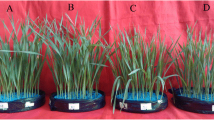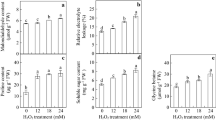Abstract
Main conclusion
We found the novel role of hydrogen sulfide in the adaptation of the alpine plant to altitude gradient in the Northern Tibetan Plateau.
Alpine plants have developed strategies to survive the extremely cold conditions prevailing at high altitudes; however, the mechanism underlying the evolution of these strategies remains unknown. Hydrogen sulfide (H2S) is an essential messenger that enhances plant tolerance to environmental stress; however, its role in alpine plant adaptation to environmental stress has not been reported until now. In this work, we conducted a comparative proteomics analysis to investigate the dynamic patterns of protein expression in Lamiophlomis rotata plants grown at three different altitudes. We identified and annotated 83 differentially expressed proteins. We found that the levels and enzyme activities of proteins involved in H2S biosynthesis markedly increased at higher altitudes, and that H2S accumulation increased. Exogenous H2S application increased antioxidant enzyme activity, which reduced ROS (reactive oxygen species) damage, and GSNOR (S-nitrosoglutathione reductase) activity, which reduced RNS (reactive nitrogen species) damage, and activated the downstream defense response, resulting in protein degradation and proline and sugar accumulation. However, such defense responses could be reversed by applying H2S biosynthesis inhibitors. Based on these findings, we conclude that L. rotata uses multiple strategies to adapt to the alpine stress environment and that H2S plays a central role during this process.











Similar content being viewed by others
Abbreviations
- APX:
-
Ascorbate peroxidase
- CAS:
-
Beta-Cyanoalanine synthase
- CAT:
-
Catalase
- CBS:
-
Cystathionine b-synthase
- CO:
-
Carbon monoxide
- CSC:
-
Cysteine synthesis complex
- CSE:
-
Cystathionine c lyase
- D-CD:
-
d-Cysteine desulfhydrase
- FDR:
-
False discovery rates
- GSH:
-
Glutathione
- GSNOR:
-
S-nitrosoglutathione reductase
- H2S:
-
Hydrogen sulfide
- D/L-CDs:
-
d/l-cysteine desulfhydrases
- NO:
-
Nitric oxide
- OAS:
-
O-acetyl serine
- OAS-TL:
-
O-acetyl-thiol-serinelyase
- ROS:
-
Reactive oxygen species
- RNS:
-
Reactive nitrogen species
- SOD:
-
Superoxide dismutase
References
Alvarez C, Calo L, Romero LC, Garcia I, Gotor C (2010) An O-acetylserine(thiol)lyase homolog with l-cysteine desulfhydrase activity regulates cysteine homeostasis in Arabidopsis. Plant Physiol 152:656–669
Alvarez C, Garcia I, Moreno I, Perez-Perez ME, Crespo JL, Romero LC, Gotor C (2012) Cysteine-generated sulfide in the cytosol negatively regulates autophagy and modulates the transcriptional profile in Arabidopsis. Plant Cell 24:4621–4634
Bai XG, Chen JH, Kong XX, Todd CD, Yang YP, Hu XY, Li DZ (2012) Carbon monoxide enhances the chilling tolerance of recalcitrant Baccaurea ramiflora seeds via nitric oxide-mediated glutathione homeostasis. Free Radic Biol Med 53:710–720
Baxter A, Mittler R, Suzuki N (2014) ROS as key players in plant stress signalling. J Exp Bot 65:1229–1240
Boehning D, Snyder SH (2003) Novel neural modulators. Annu Rev Neurosci 26:105–131
Bradford MM (1976) A rapid and sensitive method for the quantitation of microgram quantities of protein utilizing the principle of protein-dye binding. Anal Biochem 72:248–254
Briggs AG, Bent AF (2011) Poly(ADP-ribosyl)ation in plants. Trends Plant Sci 16:372–380
Chen Q, Lauzon LM, DeRocher AE, Vierling E (1990) Accumulation, stability, and localization of a major chloroplast heat-shock protein. J Cell Biol 110:1873–1883
Cheng W, Zhang L, Jiao C, Su M, Yang T, Zhou L, Peng R, Wang R, Wang C (2013) Hydrogen sulfide alleviates hypoxia-induced root tip death in Pisum sativum. Plant Physiol Biochem 70:278–286
Dixon DP, Skipsey M, Grundy NM, Edwards R (2005) Stress-induced protein S-glutathionylation in Arabidopsis. Plant Physiol 138:2233–2244
Diz AP, Martinez-Fernandez M, Rolan-Alvarez E (2012) Proteomics in evolutionary ecology: linking the genotype with the phenotype. Mol Ecol 21:1060–1080
Foyer CH, Noctor G (2013) Redox signaling in plants. Antioxid Redox Signal 18:2087–2090
Garcia-Mata C, Lamattina L (2010) Hydrogen sulphide, a novel gasotransmitter involved in guard cell signalling. New Phytol 188:977–984
Gupta R, Deswal R (2012) Low temperature stress modulated secretome analysis and purification of antifreeze protein from Hippophae rhamnoides, a Himalayan wonder plant. J Proteome Res 11:2684–2696
Hancock JT, Whiteman M (2014) Hydrogen sulfide and cell signaling: team player or referee ? Plant Physiol Biochem 78:37–42
Hare PD, Cress WA, van Staden J (1999) Proline synthesis and degradation: a model system for elucidating stress-related signal transduction. J Exp Bot 50:413–434
Herppich WB, Herppich M (1996) Ecophysiological investigations on plants of the genus Plectranthus (fam Lamiaceae) native to Yemen and southern Africa. Flora 191:401–408
Kachroo A, Robin GP (2013) Systemic signaling during plant defense. Curr Opin Plant Biol 16:527–533
Kishor P, Hong Z, Miao GH, Hu C, Verma D (1995) Overexpression of [delta]-pyrroline-5-carboxylate synthetase increases proline production and confers osmotolerance in transgenic plants. Plant Physiol 108:1387–1394
Kong X, Ma L, Yang L, Chen Q, Xiang N, Yang Y, Hu X (2014) Quantitative proteomics analysis reveals that the nuclear cap-binding complex proteins Arabidopsis CBP20 and CBP80 modulate the salt stress response. J Proteome Res 13:2495–2510
Körner C (2003) Alpine plant life: functional plant ecology of high mountain ecosystems, 2nd edn. Springer, New York
Li ZG, Yang SZ, Long WB, Yang GX, Shen ZZ (2013) Hydrogen sulphide may be a novel downstream signal molecule in nitric oxide-induced heat tolerance of maize (Zea mays L.) seedlings. Plant, Cell Environ 36:1564–1572
Liang X, Zhang L, Natarajan SK, Becker DF (2013) Proline mechanisms of stress survival. Antioxid Redox Signal 19:998–1011
Lin A, Wang Y, Tang J, Xue P, Li C, Liu L, Hu B, Yang F, Loake GJ, Chu C (2012) Nitric oxide and protein S-nitrosylation are integral to hydrogen peroxide-induced leaf cell death in rice. Plant Physiol 158:451–464
Lv X, Pu XJ, Qin GW, Zhu T, Lin HH (2014) The roles of autophagy in development and stress responses in Arabidopsis thaliana. Apoptosis 19:905–921
Mannuss A, Trapp O, Puchta H (2012) Gene regulation in response to DNA damage. Biochim Biophys Acta 1819:154–165
McCormack ML, Guo D (2014) Impacts of environmental factors on fine root lifespan. Front Plant Sci 5:205
Mok YY, Atan MS, Yoke Ping C, Zhong Jing W, Bhatia M, Moochhala S, Moore PK (2004) Role of hydrogen sulphide in haemorrhagic shock in the rat: protective effect of inhibitors of hydrogen sulphide biosynthesis. Br J Pharmacol 143:881–889
Reich PB, Ellsworth DS, Walters MB, Vose JM, Gresham C, Volin JC, Bowman WD (1999) Generality of leaf trait relationships: a test across six biomes. Ecology 80:1955–1969
Riemenschneider A, Wegele R, Schmidt A, Papenbrock J (2005) Isolation and characterization of a d-cysteine desulfhydrase protein from Arabidopsis thaliana. FEBS J 272:1291–1304
Sahu PP, Pandey G, Sharma N, Puranik S, Muthamilarasan M, Prasad M (2013) Epigenetic mechanisms of plant stress responses and adaptation. Plant Cell Rep 32:1151–1159
Scuffi D, Núñez Á, Laspina N, Gotor C, Lamattina L, Garcia-Mata C (2014) Hydrogen sulfide generated by l-cysteine desulfhydrase acts upstream of nitric oxide to modulate ABA-dependent stomatal closure. Plant Physiol. doi:10.1104/pp.114.245373
Shen JJ, Xing TJ, Yuan HH, Liu ZQ, Jin ZP, Zhang LP, Pei YX (2013) Hydrogen sulfide improves drought tolerance in Arabidopsis thaliana by microRNA expressions. PLoS One 8:e77047
Shi HT, Ye TT, Chan ZL (2014) Nitric oxide-activated hydrogen sulfide is essential for cadmium stress response in bermudagrass (Cynodon dactylon (L). Pers.). Plant Physiol Biochem 74:99–107
Stone SL (2014) The role of ubiquitin and the 26S proteasome in plant abiotic stress signaling. Frontiers Plant Sci 5: 135; doi:10.3389/fpls.2014.00135
Suzuki N, Koussevitzky S, Mittler R, Miller G (2012) ROS and redox signalling in the response of plants to abiotic stress. Plant, Cell Environ 35:259–270
Timperio AM, Egidi MG, Zolla L (2008) Proteomics applied on plant abiotic stresses: role of heat shock proteins (HSP). J Proteomics 71:391–411
Tuteja N, Sopory SK (2008) Chemical signaling under abiotic stress environment in plants. Plant Signal Behav 3:525–536
Valledor L, Jorrin J (2011) Back to the basics: maximizing the information obtained by quantitative two dimensional gel electrophoresis analyses by an appropriate experimental design and statistical analyses. J Proteomics 74:1–18
Wang P, Song CP (2008) Guard-cell signalling for hydrogen peroxide and abscisic acid. New Phytol 178:703–718
Wilson PJ, Thompson K, Hodgson JG (1999) Specific leaf area and leaf dry matter content as alternative predictors of plant strategies. New Phytol 143:155–162
Wirtz M, Hell R (2007) Dominant-negative modification reveals the regulatory function of the multimeric cysteine synthase protein complex in transgenic tobacco. Plant Cell 19:625–639
Wirtz M, Droux M, Hell R (2004) O-acetylserine (thiol) lyase: an enigmatic enzyme of plant cysteine biosynthesis revisited in Arabidopsis thaliana. J Exp Bot 55:1785–1798
Wrzaczek M, Brosche M, Kangasjarvi J (2013) ROS signaling loops–production, perception, regulation. Curr Opin Plant Biol 16:575–582
Yang G, Wu L, Jiang B, Yang W, Qi J, Cao K, Meng Q, Mustafa AK, Mu W, Zhang S, Snyder SH, Wang R (2008) H2S as a physiologic vasorelaxant: hypertension in mice with deletion of cystathionine gamma-lyase. Science 322:587–590
Yang Y, Chen J, Liu Q, Ben C, Todd CD, Shi J, Yang Y, Hu X (2012) Comparative proteomic analysis of the thermotolerant plant Portulaca oleracea acclimation to combined high temperature and humidity stress. J Proteome Res 11:3605–3623
Yang LM, Tian DG, Todd CD, Luo YM, Hu XY (2013) Comparative proteome analyses reveal that nitric oxide is an important signal molecule in the response of rice to aluminum toxicity. J Proteome Res 12:1316–1330
Zhao C, Wang XQ, Yang FS (2014) Mechanisms underlying flower color variation in Asian species of Meconopsis: a preliminary phylogenetic analysis based on chloroplast DNA and anthocyanin biosynthesis genes. J Syst Evol 52:125–133
Zhou J, Lee C, Zhong R, Ye ZH (2009) MYB58 and MYB63 are transcriptional activators of the lignin biosynthetic pathway during secondary cell wall formation in Arabidopsis. Plant Cell 21:248–266
Zhu Y, Dong AW, Shen WH (2012) Histone variants and chromatin assembly in plant abiotic stress responses. Biochim Biophys Acta 1819:343–348
Acknowledgments
We thank the members of Yang Yongping’s group for their help during sample collection. This work was supported by the Young Academic and Technical Leader Raising Foundation of Yunnan Province (No. 2012HB041), the project of innovation team of Yunnan Province, the National Natural Sciences Foundation of China (No. 31170256), and the Major State Basic Research Development Program (2010CB951700).
Author information
Authors and Affiliations
Corresponding authors
Electronic supplementary material
Below is the link to the electronic supplementary material.
425_2014_2209_MOESM2_ESM.ppt
Supplemental Fig. S1 PCA analysis of the contribution of different environmental factors to the environmental stress response. a The contribution (in percentage points) of various principal components to plant biomass, as determined in our experiments. b The contribution (in degrees) of different environmental factors in principal component 1, as determined by PCA of our data (PPT 174 kb)
425_2014_2209_MOESM3_ESM.ppt
Supplemental Fig. S2 Biological replicates of 2D gels of samples harvested from altitudes of 4350, 4,800, and 5,200 m (PPT 6079 kb)
Rights and permissions
About this article
Cite this article
Ma, L., Yang, L., Zhao, J. et al. Comparative proteomic analysis reveals the role of hydrogen sulfide in the adaptation of the alpine plant Lamiophlomis rotata to altitude gradient in the Northern Tibetan Plateau. Planta 241, 887–906 (2015). https://doi.org/10.1007/s00425-014-2209-9
Received:
Accepted:
Published:
Issue Date:
DOI: https://doi.org/10.1007/s00425-014-2209-9




